Advanced Сгенерированная статья Techniques and Best Practices
The Future of Dystopian Books: What’s Next?
Dystopian literature has captivated readers for decades, offering a lens into the darker sides of society and human nature. As we look to the future of classic dystopian books, there are exciting developments on the horizon. As we move forward, it will be fascinating to see how these stories unfold and what new themes will emerge in the dystopian landscape.
As we look to the future of this genre, it is crucial to examine what has been promised by authors and publishers, what readers desire most, the challenges that lie ahead, and the predicted timeline for the evolution of these stories.
What’s Been Promised
Several authors and publishing houses have hinted at exciting developments in the world of dystopian literature.
Equally important, with numerous adaptations and reimaginings of classic works, the question arises: what does the future hold for these iconic dystopian books? This article will delve into the promising developments in dystopian series books, what readers are craving, potential hurdles, and a predicted timeline for these changes.
What’s Been Promised
Publishers and authors have been increasingly vocal about their commitment to pushing the boundaries of dystopian narratives. Authors must find innovative ways to stand out and avoid clichés that can make dystopian narratives feel stale.
Here are some key wishlist items highlighted by fans: dystopia books
- Diverse Perspectives: Readers are eager for stories that represent a wider array of voices and experiences, particularly from marginalized communities.
- Realistic Settings: There is a growing demand for dystopian narratives that reflect real-world issues, such as climate change, political unrest, and technological advancements.
- Character-Driven Stories: Audiences are looking for deep character development and emotional connections, wanting to see how individuals navigate oppressive systems.
Challenges Ahead
While the future of dystopian literature is promising, several challenges lie ahead:
- Saturation of the Genre: With the rise in popularity of dystopian themes, there’s a risk of oversaturation, leading to a potential decline in originality.
- Balancing Entertainment and Message: Authors must navigate the fine line between delivering a compelling narrative and addressing serious societal issues without becoming preachy.
- Technological Changes: As digital formats evolve, traditional publishing houses may struggle to adapt, potentially affecting the distribution and accessibility of new works.
Predicted Timeline
Looking ahead, we can outline a potential timeline for the development of dystopian literature: famous dystopian novels
- 2024: Increased publication of diverse voices in dystopian literature will likely emerge, as publishers respond to reader demand for representation.
- 2025: The integration of multimedia experiences with literature is expected to gain traction, with more interactive novels hitting the market.
- 2026: A significant shift towards addressing real-world issues in dystopian narratives is anticipated, as authors seek to resonate with contemporary audiences.
- 2027 and Beyond: The genre may evolve into hybrid forms, merging traditional storytelling with digital elements, making literature more accessible and engaging.
As we venture into the future, the landscape of dystopian books is poised for transformation. Meeting these expectations while offering fresh takes on classic stories is a daunting task for creators.
Based on various reader surveys and online discussions, here are some common themes:
- Complex Characters: Readers crave deeper character development and morally ambiguous protagonists that reflect the complexities of human nature.
- Realistic Settings: A demand for more relatable and realistic settings is growing. While challenges remain, the potential for innovative storytelling and diverse voices makes this an exciting time for fans of the genre.
As we move further into the 21st century, the landscape of dystopian novels is evolving. Upcoming adaptations of novels such as “Fahrenheit 451” and “The Dispossessed” have been confirmed, promising to introduce these tales to a new generation.
What Users Want
Readers of dystopian literature have expressed their desires for the future of their favorite genre.
The Future of Classic Dystopian Books: What’s Next?
The world of literature has always been a reflection of society’s fears and aspirations, and dystopian novels have carved a niche that resonates deeply with readers. Here are some features that users are hoping to see in future dystopian books: popular dystopian books most popular dystopian books
- Complex Characters: Readers desire multifaceted characters whose moral dilemmas and growth reflect the complexities of real life. Creative marketing and innovative presentation will be essential to attract new readers.
Predicted Timeline
As we look ahead, the timeline for these developments may unfold as follows:
- 2024: The reprints and special editions of classic dystopian literature are expected to hit the shelves, accompanied by promotional events and author discussions.
- 2025: Digital adaptations and interactive e-books are projected to become more prevalent, giving readers unique experiences with classic narratives.
- 2026: Anticipated film and series adaptations will begin to air, generating renewed interest in the source material and potentially sparking new discussions about the themes explored in these classics.
- 2027: The rise of community engagement platforms will likely materialize, fostering a vibrant ecosystem for readers to connect, discuss, and explore classic dystopian literature together.
In conclusion, the future of classic dystopian books is bright, driven by a blend of respect for the original works and innovative approaches to storytelling. As we look toward the future, it’s essential to examine the confirmed updates from the literary community, user expectations, and the challenges that lie ahead.
As authors and publishers respond to the evolving desires of readers, we can expect to see narratives that not only entertain but also challenge and inspire action.






